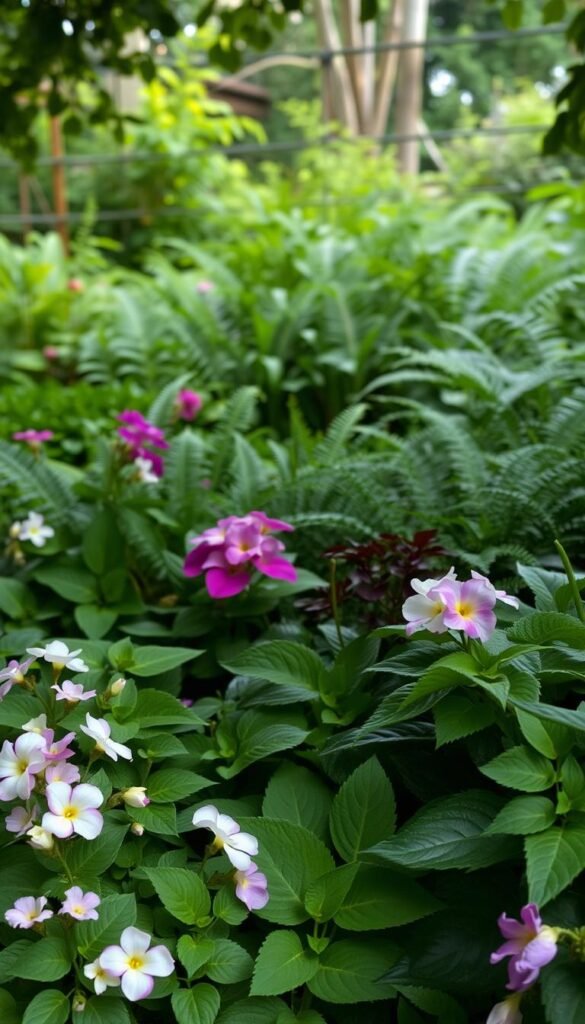Think your yard’s shadowy corners are doomed to stay dull? Think again. Transforming dim areas into vibrant retreats is simpler than you’d imagine—if you know which plants to choose. This guide reveals how to work with nature’s lighting, not against it.
Many assume that gardening success requires full sun. But beneath tree canopies or along north-facing walls, certain species truly thrive. You’ll discover varieties that burst with color even where sunlight barely filters through.
We’ll explore options for every skill level, from low-maintenance ground covers to showstopping perennials. Learn how bold textures and strategic placement can turn overlooked spaces into focal points. Proper soil prep and watering techniques matter too—we’ve got you covered.
Ready to unlock your landscape’s hidden potential? Let’s dive into plant picks that flourish where others fade, creating eye-catching displays where you least expect them.
Introduction to Shade Flower Gardens
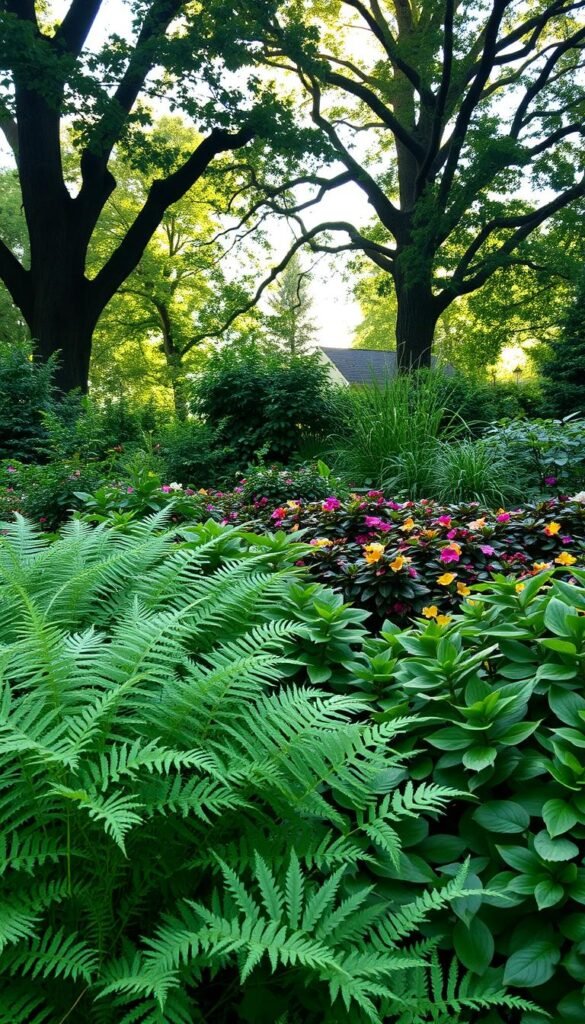
Your shaded areas might just be your garden’s best-kept secret. While sunny spots get all the attention, sheltered spaces beneath trees or along structures hold surprising potential. Over 30% of residential landscapes have naturally occurring low-light zones—areas where creativity blooms differently.
Many believe thriving greenery needs constant sunlight. But nature provides solutions for every environment. Structures like pergolas or mature maples create microclimates where temperature and moisture levels stay steadier than in open areas. These pockets often protect delicate leaves from harsh afternoon rays.
Three main light scenarios shape plant choices:
| Light Level | Description | Plant Examples |
|---|---|---|
| Full Shade | Less than 3 hours of direct light | Ferns, Hellebores |
| Partial Shade | 3-6 hours of filtered light | Hostas, Astilbe |
| Dappled Shade | Sunlight through tree canopies | Hydrangeas, Bleeding Hearts |
“Gardening in shadowed spaces isn’t about limitations—it’s discovering nature’s subtle artistry.”
These environments offer respite during summer heatwaves. You’ll notice less watering stress here compared to sun-baked beds. Texture becomes your design superpower—glossy leaves catch stray light beams while feathery fronds add movement.
Working with existing conditions saves time and resources. Instead of fighting tree roots or installing costly lighting, embrace what your space naturally provides. Your cool, tranquil corner might become your favorite outdoor retreat.
The Benefits of Shade-Loving Flowers
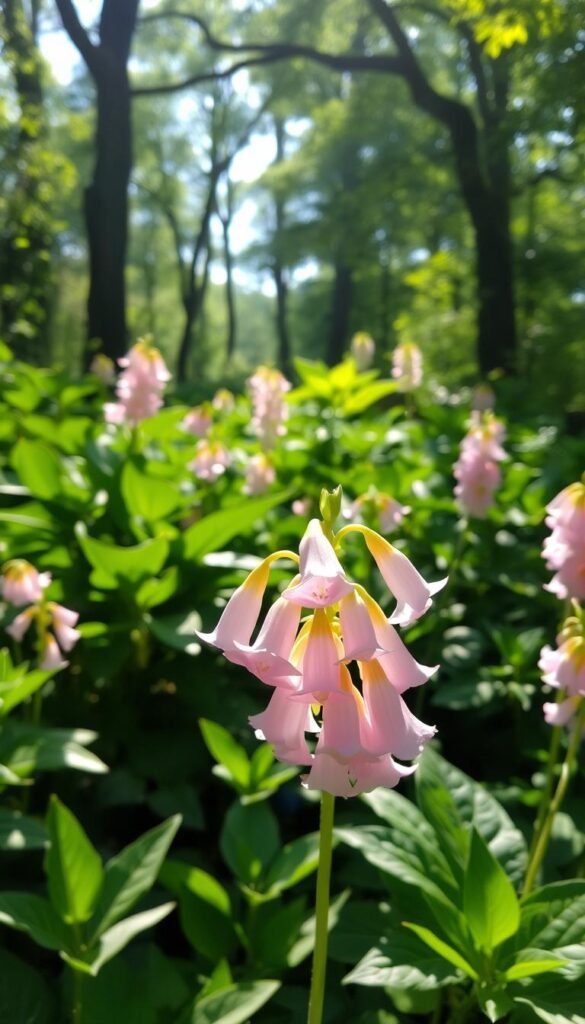
Ever wondered what magic lies in those dim corners of your yard? Shade-loving plants unlock hidden potential by splashing vivid hues and sculptural forms where sunlight rarely reaches. Their secret weapon? Leaves that reflect available light and blooms designed for subtle illumination.
These resilient flowers do more than beautify—they create mini ecosystems. Birds nestle among dense foliage, while bees visit blossoms during cooler morning hours. “These plants form critical rest stops for pollinators escaping midday heat,” notes urban ecologist Dr. Lena Torres. You’ll notice more butterflies lingering where temperatures stay moderate.
Water-wise gardeners love these varieties. Many shade-loving plants evolved in forest understories, meaning they thrive with minimal irrigation. Their blooms often outlast sun-stressed counterparts, offering weeks of color instead of days. Hydrangeas and coral bells keep their petals fresh longer under protective canopies.
Your plant palette expands dramatically when embracing low-light conditions. Delicate ferns unfurl lace-like fronds, while astilbe sends up feathery plumes in raspberry pink. You’re not just filling empty spaces—you’re crafting layered landscapes that shift with the seasons.
“A well-designed shadow garden feels like discovering a secret room in your own home.”
Creating a Vibrant Low-Light Landscape
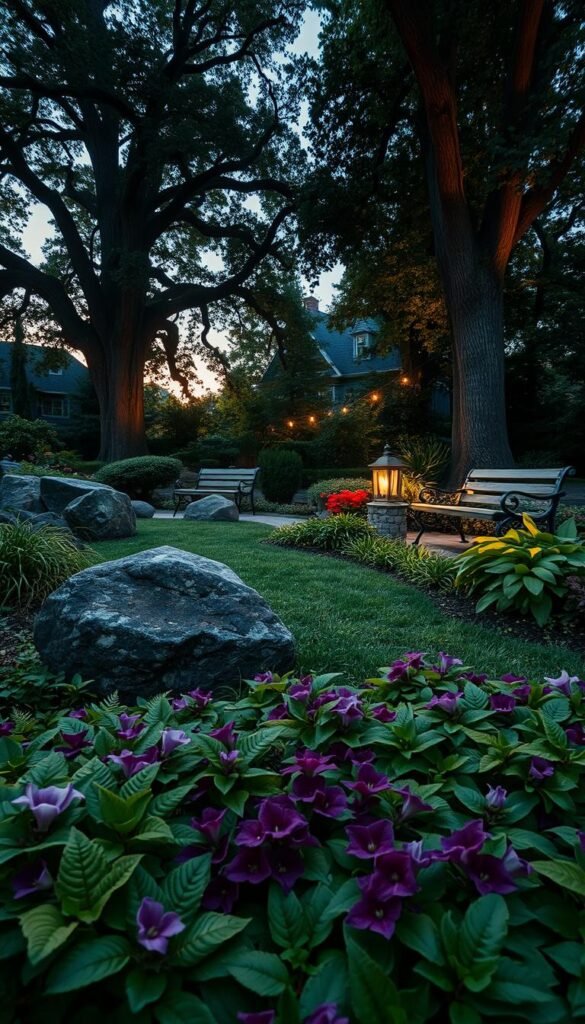
What if your shadowy nooks became the most intriguing parts of your outdoor space? Crafting captivating designs in dim areas starts with playing opposites. Bright whites and pale yellows bounce available light, while deep burgundy leaves add mystery. Think of your planting scheme as a living collage where textures do the talking.
Start with structural layers—tall foxgloves at the back, mid-height ferns in the middle, creeping thyme up front. This stacking trick creates depth where flat arrangements might disappear. For year-round appeal, mix early bloomers like lungwort with late-season stars such as toad lilies.
Hardscape elements elevate your vision. A winding stone path invites exploration, while a ceramic birdbath becomes a focal point. These features work particularly well when paired with low-maintenance flowers that require minimal fuss.
Remember this golden rule: contrast is your best friend. Pair glossy hellebore leaves with fuzzy lamium foliage. Combine spiky carex grass with rounded hosta mounds. As landscape designer Mara Jensen notes:
“In shadowy spaces, textural drama outshines floral flamboyance.”
Rotate container plants seasonally to maintain interest—spring bulbs make way for summer begonias, then autumn heucheras. This approach keeps your garden dynamic even when blooms take breaks.
Understanding Your Garden’s Shade Conditions
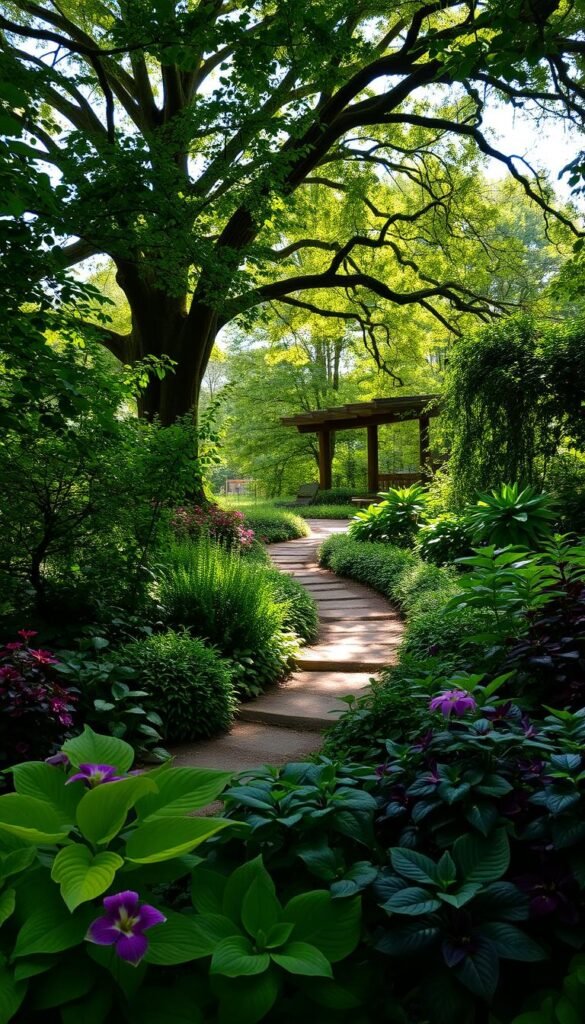
Many gardeners make a critical mistake: assuming all dim areas are created equal. Landscape designer Rebecca Sweet warns:
“Just because a plant tolerates shade doesn’t mean it thrives in it—knowing the difference is key.”
Your space might shift from morning brightness to afternoon shadows, or filter sunlight through maple branches differently than pine needles.
Start by tracking light patterns. Use a sun calculator app or mark hourly changes with chalk. Notice how structures alter conditions—a vinyl fence casts deeper shadows than lattice screens. Deciduous trees create shifting environments where spring bulbs bloom before leaf-out, while evergreens maintain steady darkness.
| Light Type | Features | Thriving Plants |
|---|---|---|
| Full Shade | Less than 3h direct sun | Japanese Forest Grass |
| Partial Shade | Morning sun only | Foamflower |
| Dappled | Filtered through leaves | Columbine |
| Filtered | Through structures | Heuchera |
Watch how winter sun angles create new bright spots. Plants surviving in deep shadows often have larger leaves to capture light, while those preferring partial shade might need 4 hours of morning rays. Test soil moisture too—dry shade under eaves differs from damp areas near downspouts.
Smartphone light meters help quantify brightness. Aim for 100-200 foot-candles for ferns, 500+ for coral bells. This data prevents costly mismatches. Remember: thriving plants bloom reliably, while tolerant ones merely survive.
Impatiens: The Vibrant Shade Annual
Looking for instant color in those tricky dim areas? Meet your new best friend: impatiens. These cheerful annuals deliver nonstop blooms even where sunlight plays hide-and-seek. Their secret? Explosive seed production and leaves that practically glow in low-light conditions.
Planting and Care Tips
Give these beauties rich, well-draining soil mixed with compost. Space plants 8-12 inches apart—their bushy growth fills gaps quickly. Watering is non-negotiable: let soil dry slightly between drinks, but never let roots bake. Mulch keeps moisture consistent during summer heat.
Watch for their signature move: ripe seed pods burst when touched, scattering future volunteers. While fun to observe, this means regular deadheading keeps plants tidy. Feed monthly with balanced fertilizer to maintain vibrant colors from May through October.
Exploring Colorful Varieties
Two main types dominate the scene:
| Type | Bloom Size | Sun Tolerance |
|---|---|---|
| Standard | 1-2 inches | Full shade |
| New Guinea | 2-3 inches | Morning sun |
Standard impatiens offer classic charm in candy-store hues. New Guinea hybrids flaunch larger flowers with striking foliage patterns. Try ‘Infinity Red’ for fire-engine pops or ‘Divine Lavender’ for soft contrast against dark-leaved companions.
“Impatiens are the neon signs of the plant world—they make shady corners impossible to ignore.”
Mix varieties in hanging baskets or window boxes for cascading color. Pair with ferns for textural drama, or let them solo in mass plantings that glow like stained glass.
Begonias: Texture and Color in Shady Spots
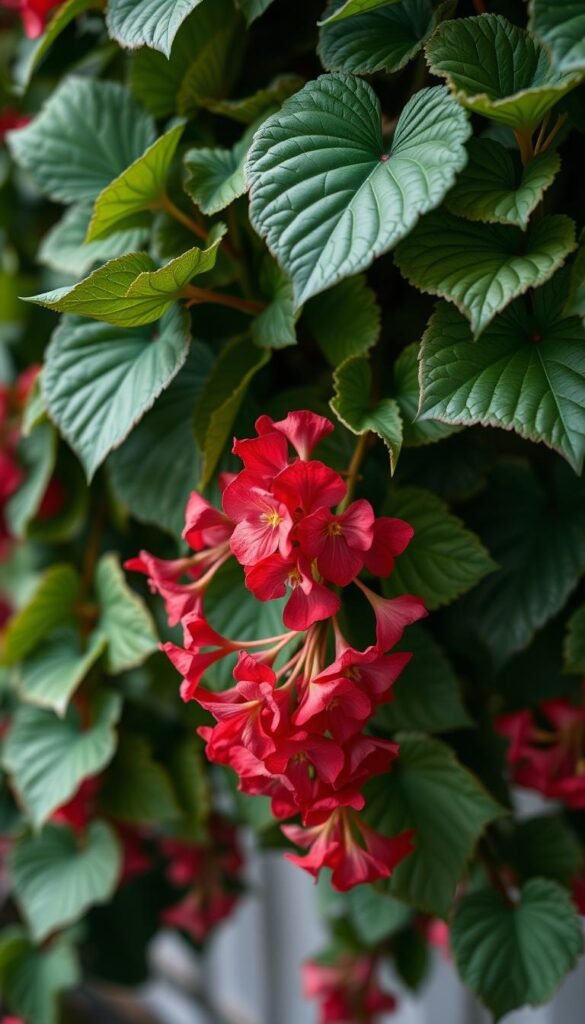
What if your dimmest garden corner became its most dazzling feature? Begonias answer with a resounding “watch this,” offering foliage that glows like stained glass and colors that pop against shadowy backdrops. These versatile plants transform lackluster areas into living art installations from spring through frost.
Foliage and Flower Highlights
Begonia leaves steal the show with metallic sheens and intricate patterns. Rex types flaunt spiral designs in raspberry and silver, while angel wing varieties display speckled leaves resembling butterfly wings. Their flowers aren’t shy either—tuberous hybrids produce rose-like blooms up to 6 inches wide.
| Type | Foliage | Blooms |
|---|---|---|
| Tuberous | Glossy green | Double flowers |
| Rex | Swirled patterns | Subtle sprays |
| Angel Wing | Speckled | Cascading clusters |
Maintenance and Growing Advice
These plants thrive with simple care:
- Use well-draining soil mixed with perlite
- Water when topsoil dries slightly
- Apply slow-release fertilizer monthly
Rotate containers weekly for even growth. Horticulturist Marcus Preston advises:
“Begonias reward consistency—keep their feet moist but never soggy, and they’ll bloom relentlessly.”
Protect from strong winds and extreme heat by positioning near structures or taller plants.
With over 1,800 varieties available, you can create ever-changing displays. Try ‘Dragon Wing’ for hanging baskets or ‘Escargot’ for container centerpieces. Their adaptability makes them perfect partners for ferns and heucheras in layered designs.
Bleeding Hearts: Romantic Blooms for Dark Corners
Imagine discovering nature’s jewelry box hidden in your shadowy spaces. Bleeding hearts deliver exactly that—delicate pendant flowers that sway like living charms. These perennials emerge each spring with fern-like foliage, followed by arching stems adorned with heart-shaped blossoms.
Their charm extends beyond aesthetics. The plants’ ephemeral nature creates anticipation—dramatic bloom displays in April and May give way to summer dormancy. This cycle makes them perfect partners for late-emerging plants that fill the gaps.
Ideal Conditions in the Shade
These woodland natives crave rich, moist soil similar to forest floors. Mix compost into planting holes and maintain consistent moisture without waterlogging. While they tolerate deep shade, morning light enhances flowering. Avoid areas where afternoon sun scorches delicate leaves.
| Variety | Color | Foliage |
|---|---|---|
| ‘Valentine’ | Ruby red | Blue-green |
| ‘Gold Heart’ | Pink | Golden yellow |
| ‘Alba’ | Pure white | Gray-green |
Seasoned gardener Elise Monroe shares:
“Pair them with hostas—the broad leaves camouflage yellowing stems in July while creating textural contrast.”
Three care essentials:
- Mulch annually with leaf mold
- Divide clumps every 3-5 years
- Mark dormant spots to avoid disturbance
With proper siting, these botanical valentines return stronger each spring, transforming forgotten corners into enchanted clearings. Their fleeting beauty reminds us to savor seasonal moments in the garden.
Hostas: Lush Greenery for Deep Shade
What if your dimmest spaces transformed into lush retreats? Enter hostas—the undisputed royalty of foliage-forward design. These Asian natives bring architectural drama to shadowed areas with leaves that range from delicate teacup sizes to dinner-plate proportions.
Variety and Size Options
With over 3,000 registered cultivars, you’ll find options for every scenario. Miniature types like ‘Mouse Ears’ stay under 6 inches, while giants like ‘Empress Wu’ stretch past 4 feet. Leaf colors shift through the season:
| Variety | Foliage | Mature Size |
|---|---|---|
| ‘Sum and Substance’ | Golden chartreuse | 30″ tall |
| ‘Blue Angel’ | Powder-blue | 48″ wide |
| ‘Patriot’ | White-edged | 22″ height |
Essential Care Guidelines
These perennials thrive when you:
- Amend soil with compost annually
- Water deeply 2-3 weekly
- Apply coffee grounds to deter slugs
Landscape designer Amy Whitworth advises:
“Use hostas as living mulch under trees—their dense leaves suppress weeds while adding visual weight.”
Rotate container specimens seasonally to prevent lopsided growth.
For textured backdrops, pair ruffled varieties with smooth-leaved heucheras. Their sculptural forms create year-round interest, even when blooms fade.
Astilbe: Graceful Plumes for Shaded Beds
Picture feathery plumes dancing in filtered light – that’s the magic astilbe brings to dim corners. These perennial showstoppers transform shadowy areas with airy blooms that seem to glow from within. Their fern-like foliage stays attractive long after flowers fade, offering multi-season appeal.
Astilbe thrives where many plants struggle. They crave consistently moist, rich soil – perfect near downspouts or under tree canopies. ‘Bridal Veil’ varieties produce creamy white spikes, while ‘Fanal’ dazzles with ruby-red plumes. For compact spaces, try dwarf types like ‘Sprite’ that max out at 12 inches tall.
Landscape designer Tamsin Westbrook advises: “Pair them with bold-leafed companions – the contrast makes both plants pop.” Combine pink cultivars with blue-leaved hostas or nestle white varieties among dark-green ferns. Divide clumps every 4 years to maintain vigorous growth.
These low-fuss beauties attract pollinators while resisting deer. Their dried seed heads add winter interest, catching frost like nature’s lace. With astilbe, even your darkest beds become luminous focal points.

